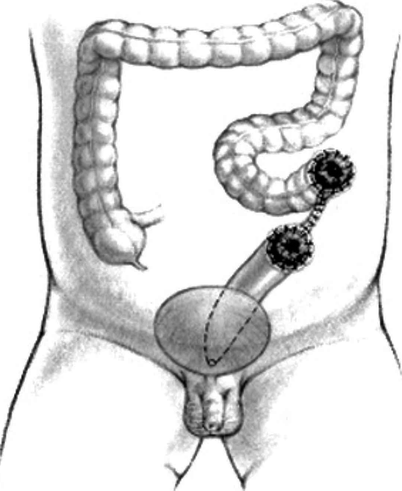Fig. 46.1
Descending colostomy

Fig. 46.2
Distal stoma made tiny and flat
An important step during the creation of a colostomy consists of irrigating the distal portion of the bowel with a saline solution until it is completely clear of meconium. The presence of meconium distally can result in fecalomas and contamination of the urinary tract when there is a fistula with the rectum.
Most Common Errors during Stoma Construction
Stoma Mislocation
Stoma mislocation can be created in different ways.
Proximal and Distal Stomas Placed Too Close to Each Other
When proximal and distal stomas are placed too close to each other, the colostomy bag covers both stomas and allows for passage of stool from the proximal to the distal stoma. As a consequence, some patients suffer from recurrent urinary tract infections. The management of this problem includes several alternatives: (1) to perform the main repair earlier than anticipated, and (2) to revise the stomas by separating them further.
The decision regarding these alternatives is made somewhat dependent on the specific clinical circumstances. If the decision is made to proceed with the main repair in a patient with this kind of colostomy, the patient may pass stool through a reconstructed area, potentially increasing the risk of infection. Alternatives in this circumstance include the following:
1.
Cleaning the entire gastrointestinal tract preoperatively, keeping the patient fasting for a period of time (usually about a week) while parenteral nutrition is initiated, or
2.
Utilizing a heavy purse-string suture in the distal stoma to occlude its lumen temporarily and avoid the distal passage of fecal material.
Colostomy Created Too Far Distally in the Sigmoid, Not Allowing Enough Distal Length for the Rectal Pull-Through
In this case the surgeon has several options (Fig. 46.3). The first is to perform the pull-through, taking down the distal stoma (mucous fistula) and closing it as a Hartmann’s pouch. Sometimes the piece of bowel is so short that it will make any future colostomy closure difficult because the anastomosis will have to be performed deep in the pelvis behind the bladder. The second option is to close the colostomy at the time of the main repair and then pull down the rectum, leaving the patient without the benefit of a protective colostomy. In this case, we recommend cleaning the entire gastrointestinal tract preoperatively and leaving the patient fasting 7–10 days while receiving parenteral nutrition. The third option is to close the colostomy, pull down the rectum, and create a proximal new colostomy to divert the stool and protect the perineum.


Fig. 46.3
Colostomy placed too distal with not enough distal bowel for the pull-through procedure (Reprinted with permission from Pena [2])
Inverted Stomas
The functional (proximal stoma) can be inadvertently placed in an inappropriate location, making it difficult to adapt the stoma bag (Fig. 46.4a, b




Stay updated, free articles. Join our Telegram channel

Full access? Get Clinical Tree








